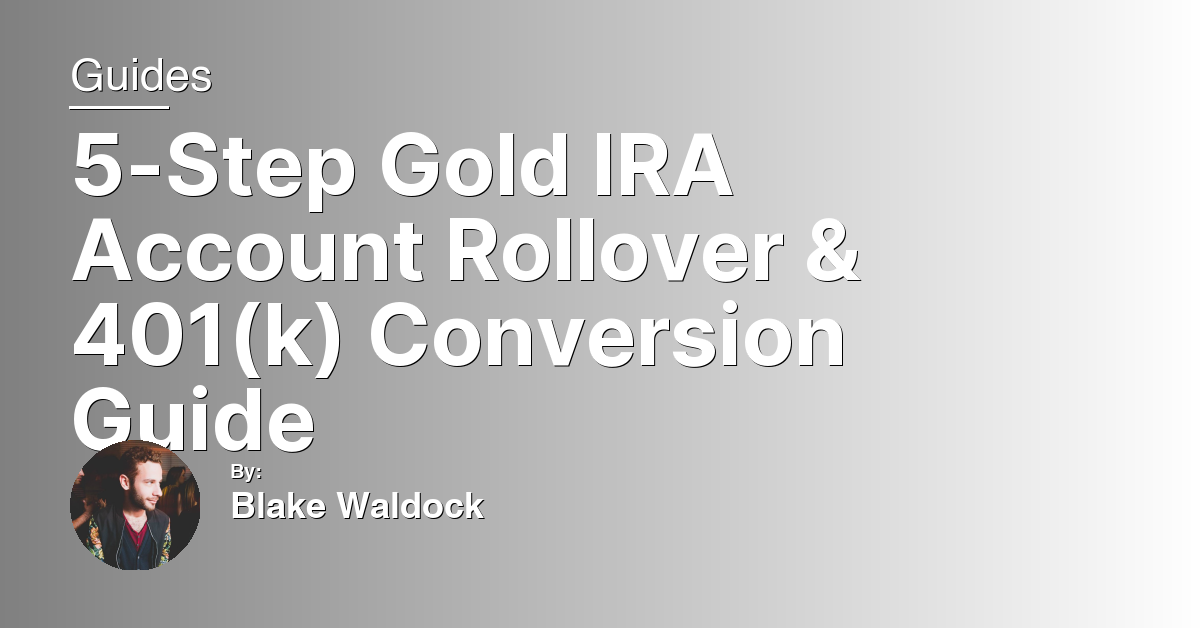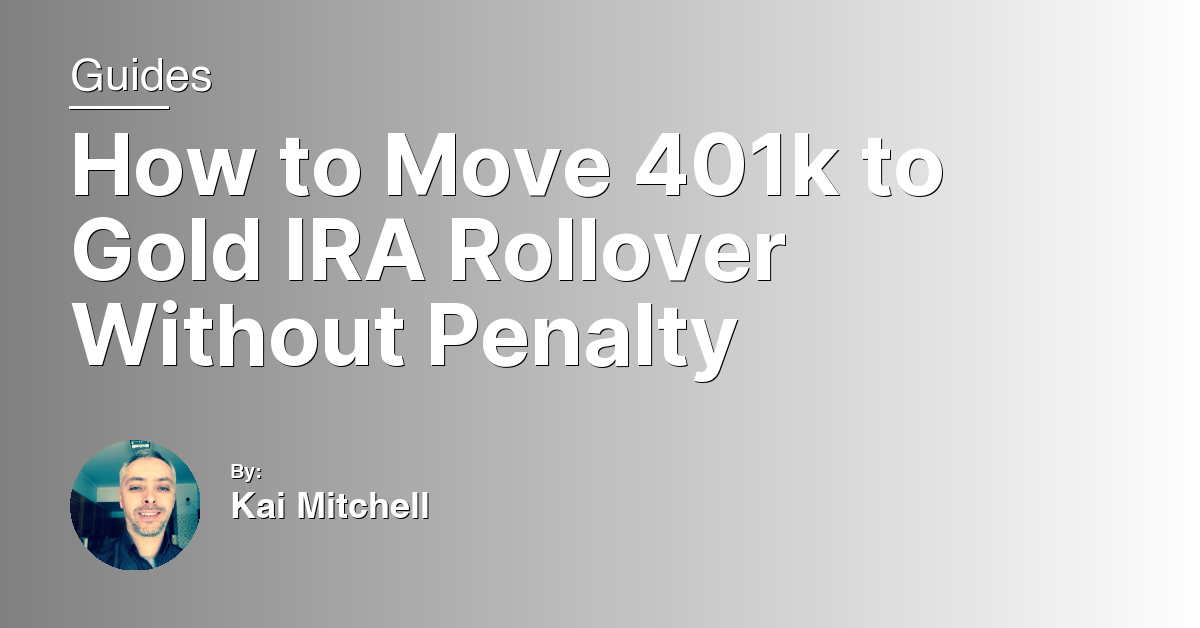Navigating the financial landscape to secure your retirement savings is a journey fraught with decision-making. One path increasingly considered by astute investors is converting their traditional 401k into gold, aiming to safeguard their nest egg against inflation and economic downturns. This ultimate guide illuminates the process of executing a 401k to gold transfer without incurring penalties, providing you with the knowledge to make a well-informed decision for your financial future.
Selecting the Right Gold IRA Company
Ensure the company is registered with the U.S. Securities and Exchange Commission (SEC) and has a solid reputation, confirmed through independent reviews and ratings on platforms like Better Business Bureau (BBB) and Trustpilot. The quality of service, including privacy policy, access control, and customer service, should be a priority in your selection process.
Investigate the company’s fee structure to avoid any hidden charges. A transparent fee schedule means you won’t face unexpected costs down the line. Additionally, consider the company’s experience in handling gold IRAs and its portfolio strategy to ensure it aligns with your financial goals and risk tolerance.
Choosing a company with a strong track record, transparency, and a commitment to security will give you confidence in your investment and help protect your retirement savings against inflation and market volatility.
Setting Up Your Self-Directed IRA
To set up your Self-Directed IRA (SDIRA) for a 401(k) to gold transfer without penalty, begin by selecting a custodian approved by the IRS that specializes in precious metals. This custodian will act as a fiduciary, ensuring your investments comply with U.S. Securities and Exchange Commission and IRS regulations, safeguarding your assets and interests.
Next, you will need to open an SDIRA account. During this process, provide all necessary documentation and choose between a traditional IRA for tax-deferred benefits or a Roth IRA for tax-free withdrawals in retirement. It’s advisable to consult with a financial adviser to understand the implications of each choice based on your current financial situation, future goals, and tax considerations.
After your SDIRA is established, you can execute a 401(k) rollover into your new account. Ensure that the rollover is performed correctly to avoid any tax penalties. This involves transferring your 401(k) funds directly into your SDIRA or receiving a check from your 401(k) provider and depositing it into your SDIRA within 60 days.
Finally, with your SDIRA funded, you can select gold or other precious metals as your investment. Work with your custodian to purchase gold that meets the purity and fineness standards required by the IRS.
Choosing Physical Gold for Your IRA
When opting for a 401k to Gold transfer, selecting physical gold for your IRA is a critical decision that hinges on factors like security, quality, and regulatory compliance. It’s vital to consult with a financial adviser who is versed in both the intricacies of a Gold IRA and the regulations set forth by the Internal Revenue Service.
Physical gold, as an asset, acts as a hedge against market volatility and inflation, offering a store of value that paper assets simply cannot match. Ensure that the gold option you choose for your Individual Retirement Account adheres to the IRS’s standards for purity and weight, thereby safeguarding your investment’s legality and potential tax advantages.
Research and select a reputable custodian with a solid track record in managing Gold IRAs. This choice significantly impacts the security and management of your precious metal assets.
Top Gold IRA Companies Overview
| Rank | Company Name | Minimum Investment | Annual Fees | Customer Reviews |
|---|---|---|---|---|
| 1 | Goldco | $10,000 | Flat fee of $175 | 4.5/5 |
| 2 | Augusta Precious Metals | $50,000 | Flat fee of $200 | 4.7/5 |
| 3 | Noble Gold | $5,000 | Flat fee of $200 | 4.3/5 |
| 4 | Advantage Gold | $25,000 | Flat fee of $250 | 4.2/5 |
| 5 | Birch Gold Group | $10,000 | Flat fee of $175 | 4.0/5 |
Understanding Gold IRA Basics
A Gold IRA, short for Individual Retirement Account, allows investors to diversify their retirement portfolio by adding precious metals like gold, which acts as a hedge against market volatility and inflation. Unlike traditional or Roth IRAs that typically hold paper assets, a Gold IRA holds physical gold as an investment, providing a unique layer of security and stability to your retirement savings.
Transferring funds from a 401(k) to a Gold IRA can be executed without incurring penalties, provided the process adheres to IRS guidelines. This involves rolling over your 401(k) assets into a self-directed IRA that permits gold and other precious metals. It’s crucial to choose a reputable custodian experienced in Gold IRAs to ensure compliance with all regulatory requirements and to safeguard your investment.
By opting for a Gold IRA, investors gain autonomy over their retirement funds, improved privacy, and an effective strategy to protect against economic uncertainties. Always conduct thorough research or consult with a financial advisor to tailor your investment choices to your long-term goals and risk tolerance.
Comparing Gold IRA and Traditional 401k
When comparing a Gold IRA with a Traditional 401(k), investors are often weighing the stability and potential hedge against economic volatility that gold offers against the more traditional retirement savings approach of a 401(k). Gold IRAs provide a unique option for those looking to diversify their portfolio with a precious metal known for its store of value, especially in times of uncertainty. Unlike the often broader investment options available in a 401(k), which may include stocks, bonds, and mutual funds, a Gold IRA focuses solely on investing in physical gold and other approved precious metals.
A key difference lies in the tax treatment and potential for tax deduction. Contributions to a Traditional 401(k) can reduce your taxable income now, but you’ll pay taxes on withdrawals in retirement. On the other hand, Gold IRAs are typically structured as Roth IRAs, meaning contributions are made with after-tax dollars, but qualifying withdrawals are tax-free.
Investors should also consider the regulatory aspect and the fact that the Internal Revenue Service (IRS) has specific rules for precious metals in IRAs, including purity standards and approved storage methods. While a Traditional 401(k) offers a degree of familiarity and ease, managed by a fiduciary who selects a range of investment options, a Gold IRA gives investors more autonomy but requires more active management and understanding of the gold market.
Choosing between these options depends on your financial goals, risk tolerance, and interest in gold as an investment. Always consult with a financial advisor to navigate these choices and ensure compliance with all regulations and laws.
Types of Gold Investments Available
Investors looking to diversify their portfolio with gold have several options. The most direct method is purchasing physical gold such as coins or bullion. This tangible asset serves as a hedge against market volatility and inflation, offering a sense of security in uncertain financial times.
For those preferring not to hold physical gold, Gold Exchange-Traded Funds (ETFs) or gold mutual funds present an alternative. These vehicles allow investors to gain exposure to gold’s price movements without the complexities of storing and insuring physical gold. They’re particularly appealing for a 401(k) to gold transfer, as they seamlessly integrate into existing retirement accounts.
Gold mining stocks and gold futures contracts are options for more experienced investors seeking leverage or speculative opportunities. However, these come with higher volatility and risk, reflecting the operational and market uncertainties inherent in mining operations and futures markets.
Each type of gold investment carries its own set of advantages, tax implications, and regulatory considerations. Choosing the right one depends on your investment goals, risk tolerance, and the regulatory framework of your retirement account.
Navigating Storage and Custodian Guidelines
When transferring your 401(k) to gold without facing penalties, understanding the storage and custodian guidelines is crucial. The IRS mandates that precious metals funded by a 401(k) must be stored in an approved depository. This means you cannot keep the metals at home or in a personal safe deposit box. Selecting a reputable custodian is essential for managing the transfer and ensuring compliance with all regulatory agency rules.
Custodians will typically be banks, credit unions, trust companies, or brokerage firms that have been approved by federal or state agencies to offer asset custody services. They will handle the purchase, sale, and storage of your gold, providing you with security and peace of mind. It’s important to review their terms of service, privacy policy, and any fees associated with their services to align with your investment goals and expectations.
Ensure you also understand the implications regarding access control, as well as how these decisions might affect the liquidity and volatility of your investment. Opting for a custodian with a strong reputation and quality of service can greatly enhance your experience and confidence in your retirement portfolio’s security.
Exploring Tax Advantages and Considerations
When transferring a 401(k) to gold, understanding the tax implications is crucial. This move can offer a hedge against economic volatility and diversify your investment portfolio, but it’s important to adhere to IRS regulations to avoid penalties.
A direct rollover from a 401(k) to a gold IRA is often the safest option, as it minimizes the risk of incurring taxes and penalties. This method ensures the funds move directly between custodians without the investor taking possession of the funds, aligning with IRS guidelines.
Investors should consider the tax advantages of such a transfer, including potential tax-deferred growth and the possibility of a tax deduction for contributions, depending on their specific financial situation. It’s essential to consult with a financial advisor or a tax professional to navigate the complexities of tax law and optimize the tax benefits.
Finally, keep in mind the long-term goal of securing your retirement finances against uncertainty and inflation. Properly executed, a 401(k) to gold transfer can be a strategic move within a broader retirement planning strategy.
FAQ
Should you convert 401k to gold?
Should you convert 401k to gold? Transitioning your 401k into a gold IRA can be a beneficial way to diversify your investment portfolio and protect your retirement funds without incurring penalties. It allows you to add a valuable asset to your financial portfolio and increase security.
Can I cash out my 401k and buy gold?
You cannot cash out your 401k and buy gold directly within the account, as most 401(k) plans do not allow for gold investments. You may need to rollover your 401(k) to an IRA or different plan in order to invest in gold.
How do I convert my retirement to gold?
To convert your retirement to gold, you must select a reputable Gold IRA company, open a Self-Directed IRA, initiate a Gold IRA rollover, purchase IRA-eligible precious metals, and store them in a secure depository.
Should I put my retirement in gold?
Putting your retirement in gold can be a good way to protect your wealth and reduce investment risk, especially during economic downturns.

